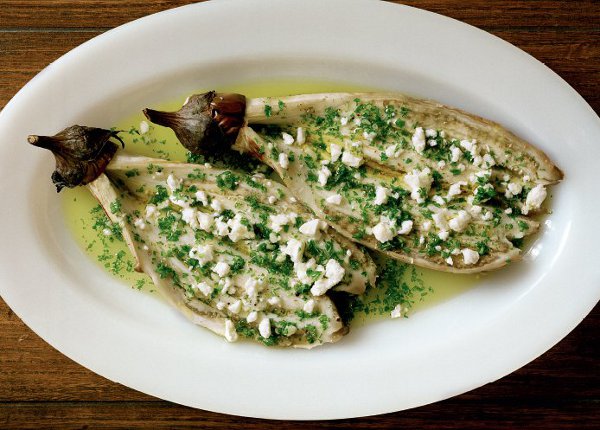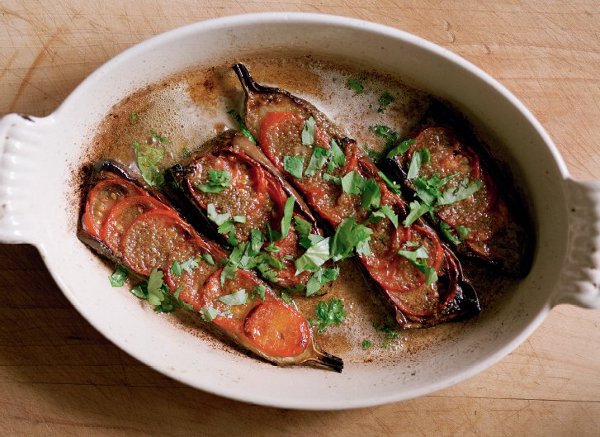Good Cook (3 page)
Authors: Simon Hopkinson
serves 4
4 long, thin-skinned purple aubergines, or 2 large, more common black-skinned ones
1–2 cloves of garlic, finely chopped
a handful of parsley leaves, finely chopped
5–6 tbsp very fine, extra virgin olive oil
a little sea salt and freshly ground black pepper
3½–5¼ oz feta cheese (best if barrel-aged)
lemons, to taste
My friend Lindsey Bareham kindly gave me this recipe. Every year, when she and a friend holiday on the Greek island of Lemnos, they enjoy their daily lunch and swim at a seaside village called Thanos, at Harry’s beachside taverna. After many requests, she eventually wheedled the recipe out of Harry, who is, all at once, cook, gardener and proprietor. I am most grateful to LB, for this is one of the very best—if not
the
best—aubergine dishes I have ever cooked and eaten. The magical moments of the dish are both its quiet simplicity, and the elemental fact, for once, of allowing the aubergine to taste exactly of itself. It further goes without saying that the oil should be very good indeed.
The very best aubergines for this dish are the long, pale purple ones, most often found in Asian stores. Their skins are nice and thin, resulting in a more thrifty discard, once peeled. The flavor is also very good, and don’t be put off by any seeds; they certainly don’t detract from the finished dish by any means. Also, it is well worth noting that when adding garlic and parsley to this kind of dish, the end result is doubly aromatic if you finely chop the two together. In French cookery, this is known as “persillade.”
Heat an overhead grill to medium hot. Run a small, sharp knife round the neck of each aubergine, about a quarter inch below the stalk and only just cutting through the skin. Then make 4 evenly spaced, shallow cuts along the length of the aubergine right down to the bulbous end. Grill them, turning every 5–7 minutes or so, until
evenly cooked and the aubergine feels soft but not too collapsed within. In the case of the purple aubergines, their skins will also have turned a dull brown color.
Transfer to a large, oval white plate and allow to cool for a couple of minutes. Now, using a small knife, deftly lift off the skin in 4 long, narrow sheets and discard (this peeling affair is an extremely pleasurable task). Without cutting right through the stalk end, cut the aubergine in half lengthways and gently pry apart until you have 2 horizontal halves, but remaining attached at the top end; a kind of elongated heart shape, if you like. Mix the garlic and parsley with the olive oil and spoon over the assembly. Season lightly with salt (the cheese is salty anyway) and pepper, crumble feta cheese over the top and squeeze over some lemon juice. If necessary, trickle over more olive oil to finish. Serve warm, or at room temperature.

serves 4
for the sauce (makes about 1 quart)
4½ lb ripe plum tomatoes
1 whole head of garlic, each clove peeled and then bruised
2 bay leaves
leaves from 1 head of fresh green celery or 2 sticks of celery, chopped
thinly pared zest of 1 small lemon
2 tsp sugar
a little salt
2 large aubergines, peeled and sliced into ¾ in thick discs
approx. 4½–5 oz olive oil
salt and freshly ground black pepper
2–3 large ladles of homemade tomato sauce (see below)
12–15 basil leaves
2 buffalo mozzarella, thinly sliced
3–4 tbsp freshly grated Parmesan
One of the best loved of all Italian aubergine dishes, but particularly so, it seems, in the US, especially in traditional, old-fashioned Italian restaurants in New York City, where the word is “eggplant”—as, in fact, it is in all other English-speaking nations in the world except here. I guess it is the proximity to France, but I have always been perplexed by this. And, by the way, the full pronunciation of this dish by most North Americans is, phonetically, “eggplant parmajahn.”
Before making this recipe, you will need to make some tomato sauce. It is quite clear that there is too much for your needs in this recipe, but it is much better to make it in large quantities and, furthermore, it freezes well. Use small, lidded plastic containers.
Plunge the tomatoes into boiling water, leave for a few seconds, then drain, cool in iced water and peel off the skins. Put all the sauce ingredients into a heavy-bottomed pan and bring to a simmer. Allow to cook very gently for 1–1½ hours, stirring from time to time. As the final sauce consistency should be a bit sloppy and still just pourable, take from the heat before it looks too thick. Personally, I like to first use a vegetable mill, using the finest disc, and then force the resultant sauce through a sieve, pressing down well with the back of a small ladle.
Preheat the oven to 400°F.
Put the aubergines into a large roasting pan and evenly douse with olive oil, while turning them over in your hands (the best way); you may not need all the oil, but they should be well coated. Season with salt.
Gently cook the aubergines in a large, dry, non-stick frying pan over a moderate heat in batches, turning once, until each side is a rich, golden brown and soft to the touch. Transfer to another tray lined with paper towels, to both cool and let any excess oil be absorbed by the paper.
Now, take a large, deep dish—which will be nice enough to go from stove to table—and cover the base with a ladleful of tomato sauce. Cover this with a single layer of aubergines, then a few basil leaves, torn, and followed by slices of mozzarella to roughly match the aubergine slices beneath. Also, grind over some pepper as you go. Repeat this layer, finishing with a thin layer of tomato sauce and more torn basil leaves. Generously sprinkle the surface with Parmesan. Bake in the oven for 30 minutes or so, or until bubbling at the edges and a gorgeous-looking golden brown on top, with nicely blistered pustules here and there. Leave to cool for about 10–15 minutes before serving, as dishes such as these can often be incendiary within.

serves 4
for the masala paste
4 tbsp cumin seeds
2 tbsp coriander seeds
2 tsp whole cloves
1 tsp (heaping) fennel seeds
1 tsp (heaping) brown mustard seeds
1 tsp (heaping) small dried red chillies
a small handful of curry leaves (fresh or dried)
1
1
/
3
cups onions, peeled and chopped
½ cup garlic cloves, peeled and chopped
2
/
3
cup ginger, peeled and chopped
2 tbsp tamarind paste
2 tsp turmeric
2 tbsp red wine vinegar
1
/
3
cup creamed coconut
2 tsp Maldon (or other) sea salt
1 tsp (heaping) superfine sugar
4 long, thin-skinned purple aubergines, or 2 large, more common black-skinned ones
approx. ¼ cup vegetable oil
salt
8 small tomatoes, or 4 large (ripe beef tomatoes, say), cored and thinly sliced
2 cloves of garlic, bruised
1–1½ tbsp masala paste, or to taste (see below)
lemon or lime juice, to taste
chopped coriander (optional)
I am so sorry, but once again a very important component of the following recipe has to be made before the dish can be completed: a homemade Indian masala paste. However, I promise that you will be glad to have it around—and it keeps for weeks and weeks in the fridge.
Using a non-stick frying pan, lightly toast the whole spices—cumin, coriander, cloves, fennel, mustard and chillies—until smelling quite wonderful and pungent, but be careful not to burn them. Tip into a small bowl to cool. In a food processor place the curry leaves, onions, garlic, ginger, tamarind paste, turmeric, vinegar,
coconut, salt and sugar. Once the spices are cool, process these in a coffee grinder, or similar, until powdered. Add to the other ingredients in the food processor and work everything until as smooth as possible; this will depend on the sharpness of your blade and the power of the machine. Do not be tempted to add the spices whole, as they will remain “bitty” if not previously powdered.
There is enough here to fill 2 small glass jars of approx. 350ml capacity. Cover with a film of oil, put on a lid and store in the fridge until needed. Each time you use some, smooth over the surface once more, then cover with a little more oil to seal.
So, now to make the dish itself…
Preheat the broiler.
Cut the aubergines in half lengthways and criss-cross the open surfaces with a small, sharp knife, about halfway down into the flesh. Generously brush with oil and season with salt. Place under the broiler, not too close, and allow to cook through until golden, soft within and very slightly sunken. Cool slightly, then cover the surfaces with overlapping sliced tomatoes. Keep the broiler on, but at a lower temperature.
Warm about 4–5 tablespoons of oil with the garlic and 1½ tablespoons of the masala paste for a few minutes. Fish out the garlic and then spoon the flavored oil over the tomato-topped aubergine halves. Return to the broiler—again, not too close—and cook until the tomatoes are well burnished and the spices are smelling deliciously aromatic. Serve with lemon or lime juice squeezed over together with some chopped coriander, if you like. Very good indeed eaten with a bowl of super-cool yogurt mixed with some freshly chopped mint.

